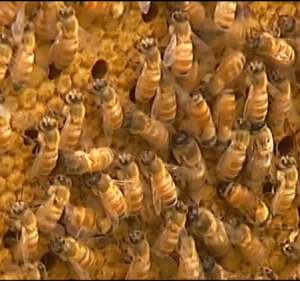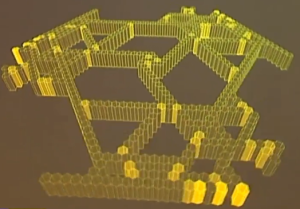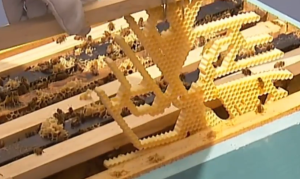 Most people have pretty strong opinions about bees. If you’re allergic, it’s perfectly understandable to want to avoid them at all costs. But in terms of the non-allergic population, most of us don’t appreciate bees nearly enough. Climate change, certain industrial practices and pesticides are all contributors to the dramatic decline of the bee population, and that’s far more dangerous to humans than any bee sting (again, allergy sufferers excepted). Whether you like them or not, bees and their pollinating activity are critical to maintaining our food supply. And right now, the bees are stressed and exhausted.
Most people have pretty strong opinions about bees. If you’re allergic, it’s perfectly understandable to want to avoid them at all costs. But in terms of the non-allergic population, most of us don’t appreciate bees nearly enough. Climate change, certain industrial practices and pesticides are all contributors to the dramatic decline of the bee population, and that’s far more dangerous to humans than any bee sting (again, allergy sufferers excepted). Whether you like them or not, bees and their pollinating activity are critical to maintaining our food supply. And right now, the bees are stressed and exhausted.
Researchers at New Zealand’s Auckland University of Technology have used 3D printing to come up with a way to take some stress off of the bees. They haven’t developed a solution to colony collapse disorder, which concerns makers around the world, but they have found a way to assist with bees’ most stressful, energy-consuming task – making honeycomb. The waxy comb is required for the bees to store their honey, but building it takes a great amount of time and effort, leaving the bees with less energy for pollination and honey-making.
 Professors at AUT have developed a solution – 3D printed honeycomb (a rather different version from one created for beekeepers earlier this year). The model for the comb was developed using a complex computer software, which created the design using sound waves.
Professors at AUT have developed a solution – 3D printed honeycomb (a rather different version from one created for beekeepers earlier this year). The model for the comb was developed using a complex computer software, which created the design using sound waves.
“It’s software that analyses the sound of an interior of a beehive, and the software not only analyses the sound [but] it also creates 3D objects at the same time,” said designer Gerbrand van Melle.
The model created by the software was printed and incorporated into hives kept by the researchers, and they took to it as readily as they would to naturally produced honeycomb. The success of the printed comb was largely in thanks to the sophistication of the software, which was able to replicate the very precise structure of natural honeycomb. Printing a honeycomb-like shape wasn’t enough; it turns out that bees are very particular about their space.
“One of the key things about bees is that they have a thing called bee space,” said Professor Peter Dearden. “They like spaces of particular sizes. It has to be very precise and accurate, so 3D printing seems like a great way to build up those things if you want to put in devices to cause bees to act in a particular way.”
 The designers aren’t finished; they are now working on a way to 3D print honeycomb using actual beeswax. So far, though, the project has been very successful in saving the bees time and energy. About 60,000 bees and a week’s time – in perfect conditions – are required to make the same amount of comb that a 3D printer can make in one day. Without having to spend that time building the comb, the bees can focus a lot more of their energy on their most important task – pollination, which is so vital to humans and our production of food. Since the decline of bee populations is largely due to human activity, it seems that the least we can do is use our advanced technology to make things a little bit easier on them. Discuss this article in the 3D Printed Honeycomb forum on 3DPB.com.
The designers aren’t finished; they are now working on a way to 3D print honeycomb using actual beeswax. So far, though, the project has been very successful in saving the bees time and energy. About 60,000 bees and a week’s time – in perfect conditions – are required to make the same amount of comb that a 3D printer can make in one day. Without having to spend that time building the comb, the bees can focus a lot more of their energy on their most important task – pollination, which is so vital to humans and our production of food. Since the decline of bee populations is largely due to human activity, it seems that the least we can do is use our advanced technology to make things a little bit easier on them. Discuss this article in the 3D Printed Honeycomb forum on 3DPB.com.
Subscribe to Our Email Newsletter
Stay up-to-date on all the latest news from the 3D printing industry and receive information and offers from third party vendors.
You May Also Like
3D Printing Financials: Fathom Struggles in Financial Quicksand During Critical Transition
Facing a year of key transitions and financial pressures, Fathom (Nasdaq: FTHM) has filed its annual report for 2023 with the U.S. Securities and Exchange Commission (SEC). The document outlines...
Latest Earnings Overview for Australian 3D Printing Firms Titomic and AML3D
Australian 3D printing manufacturing firms Titomic (ASX: TTT) and AML3D (ASX: AL3) reported their financial results for the period from July to December 2023, marking the first half of their...
3D Printing Webinar and Event Roundup: April 7, 2024
Webinars and events in the 3D printing industry are picking back up this week! Sea-Air-Space is coming to Maryland, and SAE International is sponsoring a 3D Systems webinar about 3D...
3D Printing Financials: Unpacking Farsoon and BLT’s 2023 Performance
In the Chinese 3D printing industry, two companies, Farsoon (SHA: 688433) and Bright Laser Technologies, or BLT (SHA: 688333), have recently unveiled their full-year earnings for 2023. Farsoon reported increases...
































